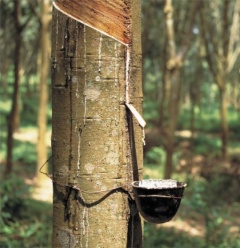Difference between revisions of "Gutta Percha"
(Created page with "A dried resin obtained from trees antive to Malaysia. Shipped in bags or cases. Used in dentistry and as an insulating medium in electrical products. Is stiff, hard and inelastic...") |
|||
| (6 intermediate revisions by the same user not shown) | |||
| Line 1: | Line 1: | ||
| − | + | {{Infobox_Other_organic | |
| + | | image = Gutta_Percha.jpg | ||
| + | | origin = See text | ||
| + | | stowage factor = 2,4 m<sup>3</sup>/t (bags/cases) | ||
| + | | humidity and moisture = - | ||
| + | | ventilation = - | ||
| + | | risk factors = See text | ||
| + | }} | ||
| + | ==Description== | ||
| + | Gutta-percha is a genus of tropical trees native to Southeast Asia and northern Australasia, from Taiwan south to the Malay Peninsula and east to the Solomon Islands. The same term is used to refer to an inelastic natural latex produced from the sap of these trees, particularly from the species Palaquium gutta. Chemically, gutta-percha is a polyterpene, a polymer of isoprene, or polyisoprene, specifically. Heavy use of gutta-percha during the second half of the nineteenth century, particularly as insulation for underwater telegraph cables, led to unsustainable harvesting and a collapse of the supply.<br><br> | ||
| + | ==Application== | ||
| + | <b>Electronics</b><br> | ||
| + | Gutta-percha latex is biologically inert, resilient, and is a good electrical insulator with a high dielectric strength. The wood of many species is also valuable.<br><br> | ||
| + | <b>Dentistry</b><br> | ||
| + | The same bioinertness that made it suitable for marine cables also means it does not readily react within the human body. It is consequently used in a variety of surgical devices and for dental applications during root canal therapy. It is the predominant material used to obturate, or fill the empty space inside the root of a tooth after it has undergone endodontic therapy. Its physical and chemical properties, including but not limited to its inertness and biocompatibility, melting point, ductility and malleability, afford it an important role in the field of endodontics.<br><br> | ||
| + | <b>Other uses</b><br> | ||
| + | In the mid-19<sup>th</sup> century, gutta-percha was also used to make [[furniture]].<br><br> | ||
| + | ==Shipment / Storage / Risk factors== | ||
| + | Shipped in bags or cases. Is stiff, hard and inelastic when cold. Softens to mouldable condition at 60°C and melts at 100°C. Insoluble in water, essentially soluble in carbon disulphide, petroleum [[ether]] and [[chloroform]]. It can be vulcanised with [[sulphur]].<br><br> | ||
| + | Subject to loss in weight due to drying out.<br><br> | ||
| + | |||
| + | |||
[[Category:Products]] | [[Category:Products]] | ||
| + | [[Category:Other organic material]] | ||
Latest revision as of 09:05, 27 June 2013
| Infobox on Gutta Percha | |
|---|---|
| Example of Gutta Percha |  |
| Facts | |
| Origin | See text |
| Stowage factor (in m3/t) | 2,4 m3/t (bags/cases) |
| Humidity / moisture | - |
| Ventilation | - |
| Risk factors | See text |
Gutta Percha
Description
Gutta-percha is a genus of tropical trees native to Southeast Asia and northern Australasia, from Taiwan south to the Malay Peninsula and east to the Solomon Islands. The same term is used to refer to an inelastic natural latex produced from the sap of these trees, particularly from the species Palaquium gutta. Chemically, gutta-percha is a polyterpene, a polymer of isoprene, or polyisoprene, specifically. Heavy use of gutta-percha during the second half of the nineteenth century, particularly as insulation for underwater telegraph cables, led to unsustainable harvesting and a collapse of the supply.
Application
Electronics
Gutta-percha latex is biologically inert, resilient, and is a good electrical insulator with a high dielectric strength. The wood of many species is also valuable.
Dentistry
The same bioinertness that made it suitable for marine cables also means it does not readily react within the human body. It is consequently used in a variety of surgical devices and for dental applications during root canal therapy. It is the predominant material used to obturate, or fill the empty space inside the root of a tooth after it has undergone endodontic therapy. Its physical and chemical properties, including but not limited to its inertness and biocompatibility, melting point, ductility and malleability, afford it an important role in the field of endodontics.
Other uses
In the mid-19th century, gutta-percha was also used to make furniture.
Shipment / Storage / Risk factors
Shipped in bags or cases. Is stiff, hard and inelastic when cold. Softens to mouldable condition at 60°C and melts at 100°C. Insoluble in water, essentially soluble in carbon disulphide, petroleum ether and chloroform. It can be vulcanised with sulphur.
Subject to loss in weight due to drying out.











